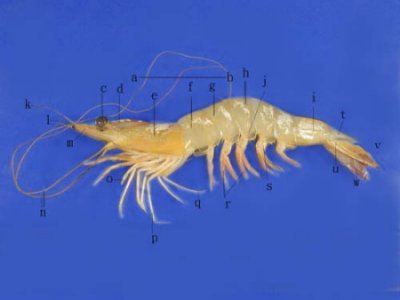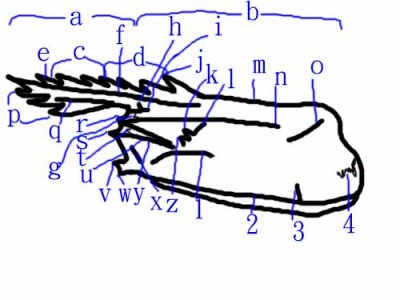![]() General Morphology: whole body, carapace.
General Morphology: whole body, carapace.
![]() Families: Penaeidae,Solenoceridae.
Families: Penaeidae,Solenoceridae.

a. Cephalothorax
b. Abdomen
c. Eye
d. Rostrum
e. Carapace
f. First abdominal segment
g. Tergite
h. Third abdominal segment
i. Sixth abdominal segment
j. Pleuron
k. Upper/ Dorsal antennular flagellum
l. Lower/ Ventral antennular flagellum
m. Scaphocerite
n. Antennal flagellum
o. Chela
p. Third pereiopod
q. Fifth pereiopod
r. Pleopods
s. Protopodite
t. Telson
u. Protopodite
v. Endopod of uropod
w. Exopod of uropod

a. Rostral length
b. Carapace length
c. Upper/ Dorsal rostral teeth
d. Post-rostral teeth
e. Last dorsal rostral tooth
f. Adrostral groove
g. Post-orbital spine
h. Post-orbital groove
i. Gastro-frontal carina
j. First post-rostral tooth
k. Supra-hepatic spine
l. Cervical carina
m. Post-rostral carina
n. Longitudinal suture
o. Branchio-cardiac groove
p. Lower/Ventral rostral teeth
q. Lateral carina
r .Orbital spine
s. Antennal spine
t. Post-antennal spine
u. Antennal carina
v. Branchiostegal spine
w. Ptergostomian spine
x. Antennal groove
y. Gastro-orbital carina
z. Hepatic spine
Family Penaeidae
The rostrum is well developed and the two antennular flagella are of similar length. The cervical groove does not reach dorsal carapace. In this family, the members of the Genus Penaeus are large and abundant, and traditionally a highly valued seafood of major commercial importance. The next important genus is Metapenaeus. Some members of these two genera are cultured by fishermen.
Family Solenoceridae
The body color of this family is generally pink to red. The members of the Genus Solenocera are the main commercial species. Solenocerids have the antennular flagella of similar length, and the cervical groove reaches to dorsal carapace.